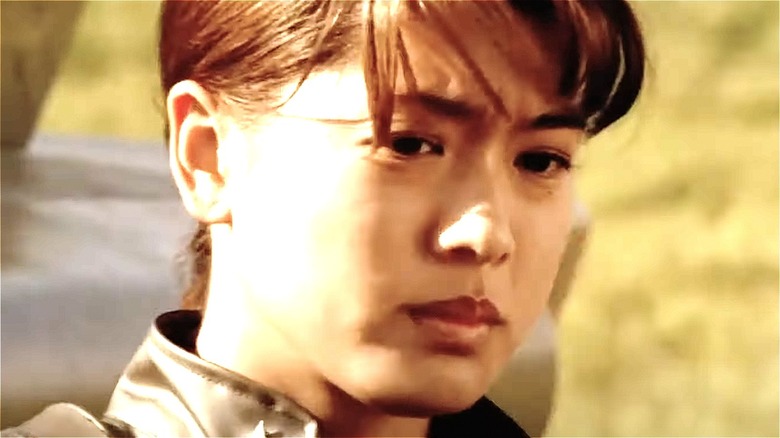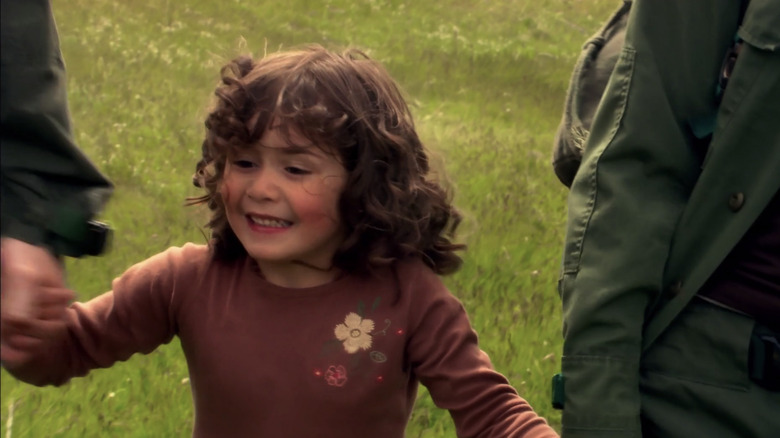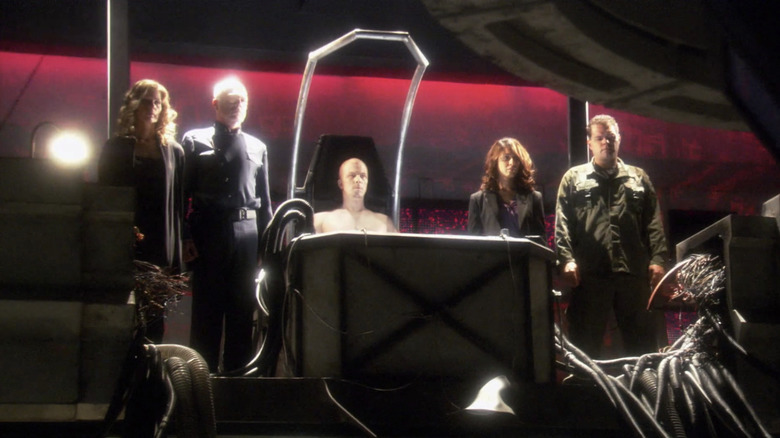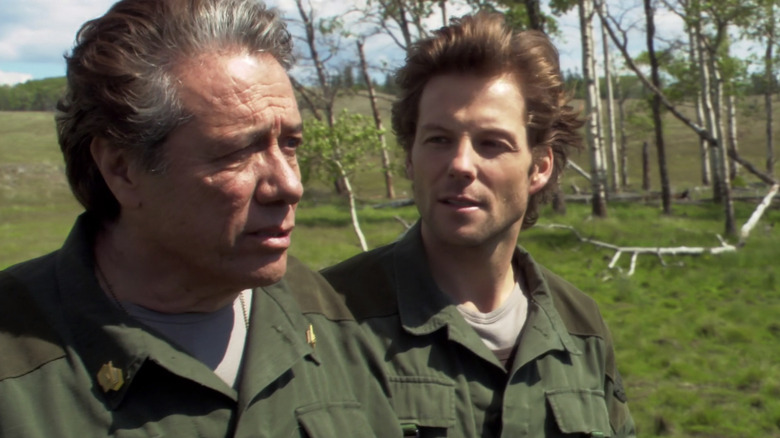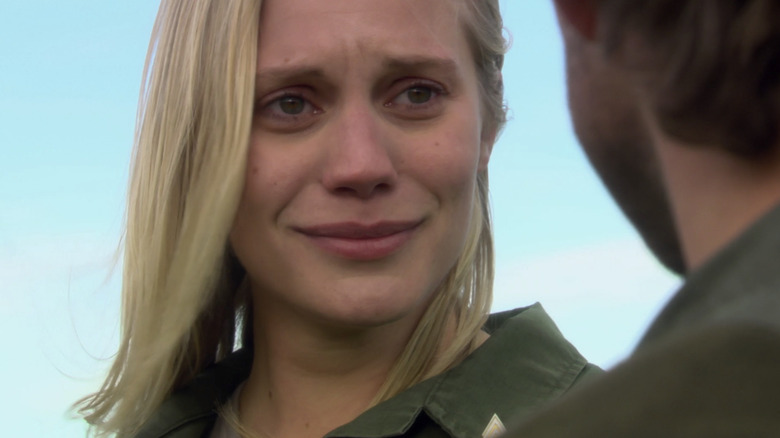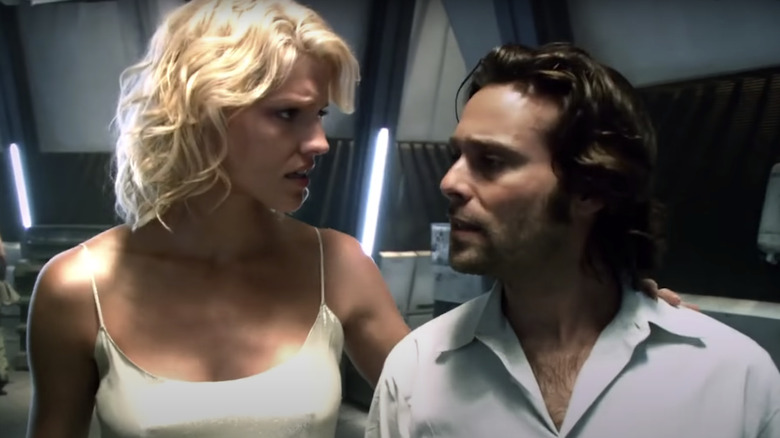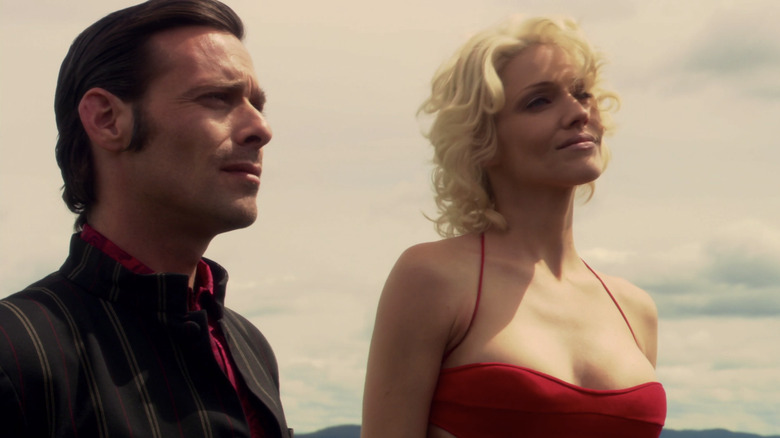The Ending Of Battlestar Galactica Finally Explained
SyFy's "Battlestar Galactica" has stood the test of time, continuing to be celebrated as one of the most influential sci-fi television shows of the 21st century. To this day, the show — which still has a 95% on Rotten Tomatoes – remains iconic, and the new reboot in the works has its work cut out for it.
The series kicked off initially in 2003, with a three-hour miniseries that introduced viewers to the gritty, political, and spiritual reboot, which was a far cry from the more "Star Wars"-influenced "Battlestar Galactica" of the 1970s, and successful twisted the tropes of the former series on their head: not only was ace Viper pilot Starbuck (Katee Sackhoff) a woman, but she maintained the cigar-smoking, punch-throwing characteristics of her male counterpart. Cylons, meanwhile, were made into a far more complex and sympathetic species, rather than the more straightforward antagonists of the original series.
"Battlestar Galactica," throughout its four seasons, poses compelling conversations about religious fanaticism and what it means to be human. Years later, these elements of the series continue to be dissected by publications as important as The Guardian, and nowhere are they more integral to the narrative than the show's final stretch. That said, the final episodes of "Battlestar Galactica" leave a lot to unpack, as four seasons of lore lead to a divisive finish line.
The final battle revolves around Hera
"Battlestar Galactica" begins and ends with the same central conflict — what does it mean to be human? And are Cylons, in fact, human beings?
At first, the differences between the humans and the Cylons seem so vast that nothing could ever bridge them ... that is, until the Cylon Sharon "Athena" Agathon (Grace Park) — a Number Eight Cylon model — and Karl "Helo" Agathon (Tahmoh Penikett) fall in love. Against all Cylon and human beliefs, they biologically reproduce, and have a daughter named Hera.
This seems as though it would unite the two warring societies for the better. Instead, it sows more discord. The finale culminates in Boomer (Park) — a different Number Eight from Athena – kidnapping Hera and bringing her to the Cylon leader Cavil (Dean Stockwell) so they can dissect her and figure out how to reproduce a child on their own. In a sense, this does bring humans and Cylons together, because Admiral Bill Adama (Edward James Olmos) rallies Cylons and humans alike to save Hera. Gaius Baltar (James Callis) and Number Six serve their destiny by helping rescue Hera and deliver her to her parents.
The two civilizations come to terms by giving Cavil's Cylons the plans to implement resurrection: This would mean they would once again have the ability to download their consciousness into identical bodies before death. But even with a perfect solution for both parties, the humans and Cylons can't make it work. Not trusting the humans, the Cylons open fire. This forces the humans — and some Cylons — to jump away and look for a new home.
The Final Five
Since humanity first learned that the Cylons had taken on synthetic forms, there was a mad dash to discover their human identities. Number Six reveals herself first, and she tells Baltar that there are twelve models. Throughout the series, these models are slowly discovered, such as Leoben (Callum Keith Rennie), Sharon, D'Anna (Lucy Lawless) and Cavil (Dean Stockton).
However, toward the end of the series, there remains the mystery of The Final Five. These Cylons are significant because they are scientists and responsible for the creation of the resurrection technology.
In a shocking twist, the five are revealed to have no memory of their origins until they all hear the same song, "All Along the Watchtower." Even more surprisingly, the Final Five are all characters the audience has come to know at different points in the series, whom had previously seemed to be humans. They include Chief Tyrol (Aaron Douglas), Tory (Rekha Sharma), Anders (Michael Trucco), Saul Tigh (Michael Hogan), and Ellen (Kate Vernon). The resurrection ensured that they would find each other in the next life, as they were later born on the Twelve Colonies. The Final Five are different from other Cylon models: they can age, and have a moral code that Cylons like Cavil do not. They also want to ensure that humanity and Cylons can come to a resolution, where they can all thrive. However, this dream is only achieved when the rebel Cylons and crew of Galactica jump to a new home.
Galactica finds Earth (again)
The search for Earth has been the primary goal for the characters of "Battlestar Galactica" since they were attacked by the Cylons. This legendary planet holds mythical significance for the characters, and it is seen as a refuge where the characters can safely restart society.
However, in one of the most brilliant twists of the series, the discovery of Earth is a letdown — because after being guided by divine coordinates, the characters find that Earth is a nuclear wasteland. It was, in fact, the planet that the Cylons had found refuge after the first war with humans. They evolved on their own, but ultimately, they made the same mistakes as humans: War broke out because of the advancement of technology.
The series finale of "Battlestar Galactica," though, sees the characters jump to a lush planet that is new to them, but quite familiar to viewers. This is Earth as the audience knows it — only thousands of years before present day. In other words, even though viewers had been led to believe, until now, that "Battlestar Galactica" takes place in the distant future, the series has actually been unfolding in the distant past. While Galactica and the Cylons have been having their wars, Earth (as we know it) had yet to develop.
Galactica lands on Earth and decides to make a home there, without the sins of the past. They settle in different parts of the world, while flying their advanced technology into the sun. This way the human race can really start fresh with a blank slate. Cylons and humans alike agree to start over and begin anew.
Nothing but the rain
The finale of "Battlestar Galactica" also comes full circle in regard to arguably its most important character, Kara "Starbuck" Thrace. Kara is first introduced in conjunction with her paternal relationship with Adama. In the final episode, their last interaction follows the pattern of how their first began: Adama asks, "What do you hear?" and her response, as always, is "Nothing but the rain."
This emotional sendoff is made even more heartfelt when she says goodbye to Lee (Jamie Bamber). The two had a tumultuous relationship, where they could never let go of each other. But this time, Lee has to finally move on ... because Starbuck is not actually there.
Why is Starbuck missing? There are some breadcrumbs to follow. Earlier in the season, Starbuck found her own remains in the ruins of her Viper on the Cylon's Earth. At the time, she was confused at seeing her own dead body, but now she has accepted her fate: When she flew to Earth, she died, and that's why her corpse is there. Following that, a version of "Starbuck" reappeared, but only to help the Galactica finish her mission — and now that she has helped end the Cylon war, and settled humanity in a new home, she isn't needed anymore. She can move on to the next phase. While Lee is telling her of all the amazing things he plans on doing in his new home, she vanishes.
He has a new life ahead of him, but heartbreakingly, he has to move forward without her.
The truth behind Six and Baltar's visions
One of the main pressing mysteries remaining on "Battlestar Galactica" was the source of Baltar's visions. After the fall of Caprica, Baltar escapes treason by being brought on board the Galactica. There, he thought he was free of any indictment until he started seeing Six, the Cylon he gave defense secrets to — an action which ensured the nuclear apocalypse of Caprica. Baltar becomes even more disturbed to discover that he is the only one that can see her. Six guides Gaius into decisions that avoid his implication, but he doesn't understand why, much less what she is. Six tells him that he is part of God's plan, though it is unclear — for most of the show — if this is the truth.
Further complicating matters is the reveal that Caprica Six, in the real world, has her own vision of Baltar, who also tells her she is implementing God's plan. This all comes to a head when Caprica Six and Gaius save Hera. Their visions tell them that they have saved humanity by saving Hera. In fact, the "hallucinatory" versions of Six and Baltar are just as divine as they claimed to be. These Six and Gaius visions imply that they are doing the work for God — though the deity "doesn't like that name," as Gaius tells Six.
They are here to ensure that humanity is on the right path, and simply used real Gaius and Six as their instruments. Only time will tell if their efforts saved humanity from itself. In that regard, a flash-forward at the conclusion of the final episode points toward an answer ...
All this has happened before and all will happen again
The final scene of the series takes place 150,000 years after the main events of the episode and serves as its epilogue. Six and Baltar — who are essentially soldiers for a divine being — walk around present-day New York talking about a new discovery. Scientists have discovered "Mitochondrial Eve," who is the beginning of all human life as they know it: in fact, Mitochondrial Eve is Hera, who was a Cylon-human hybrid.
Six and Baltar see that Earth is heading towards the same technological advancements that destroyed earlier advanced civilizations. This brings up a main thematic point that has been instilled in the show since the beginning: Six regularly recites a motto that "all this has happened before," and the question is if history will repeat itself (as it always does). Indeed, humanity fails at learning from its mistakes, and Earth is heading closer and closer to robotic AI.
What happens next? Six thinks that the slate was wiped clean enough that there will be no need to intervene in this civilization, but it remains to be seen if she is right or not.
"Battlestar Galactica" raises many interesting ideas about religion, technology, and how history repeats itself. There is no telling yet which way the pendulum will swing: will humanity save itself or repeat the sins of its past? And in the show, just as in real life, the answer remains mysterious.
